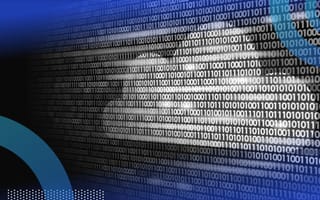In order to convert binary numbers to letters, it’s important that you understand how to count in binary. Once you understand the number system in binary code, it’s not that difficult to convert those numbers into letters and vice-versa.
How to Read Binary Letters
Binary numbers are converted into letters using the American Standard Code for Information Interchange (ASCII) codes. Each letter consists of eight numbers. Uppercase letters start with 010 and lowercase letters start with 011. The letter “a” is 01100001. From there, count the number of the letter and write that number in binary. For example, the letter “d” is the fourth letter (100), which is written as 01100100 in binary.
Actually, I enjoy writing binary code so much that I created a decal for my laptop cover! Can you decipher it?

How to Convert Binary Numbers Into Letters
The first thing you need to know is that we will be converting the binary numbers into letters using the American Standard Code for Information Interchange (ASCII) codes. ASCII codes represent text in computers, telecommunication equipment and many other devices. Most modern character-encoding schemes are based on ASCII.

In the above chart, we have all the letters in the alphabet, both capitalized and lowercase versions. We see that uppercase letters start at what is equivalent to the binary number 01000001 (65), and lowercase letters start at what is equivalent to the binary number 01100001 (97). An easier way to remember what number the letters begin at is to think of just the first three numbers in binary: 010 and 011. If you can remember this, then all you have to do is place a 1 at the very end of the 8 digits and you have the letter A | a.
Another way to think about it is to find the value of how many letters you are away from “A” in the alphabet and then just write that value in binary code. So, if I am going to write the letter D, then I could begin to count starting at “A” with number 1, “B” is 2, “C” is 3, “D” is 4. So, the number 4 is what I would write in binary code, like so: 100.
Binary Letters: Upper-Case and Lower-Case
Now all we have to do is determine if we want to capitalize the letter or leave it lowercase. If we want to capitalize it, then we know the first three numbers must be 010. With the first three numbers, plus the value of our letter, we can just fill in the middle area with 0s since we need to have eight numbers total. Once we’ve placed the 0s in between, we get 01000100. This is the ASCII code for the letter “D!”
Let’s go over one more letter just to really solidify this concept. Let’s work with the letter “Z.” First, we count how many letters away we are from “A.” Since we picked the last letter in the alphabet, we can determine that the letter “Z” is partially represented by the binary number 26. The number 26 looks like 11010 in binary code. Now, all we have to do is figure out if we want lowercase or uppercase. This time we will go with a lowercase value, so we prepend the value 010 to the binary code and end up with 01011010 which represents “z” in ASCII code.
Understanding Binary Letters
With that, we’ve covered ASCII codes and shown how to write letters using binary numbers. But this is just the beginning. Think about all the special characters out there, such as &, /, @ and !, and so on. Those all have ASCII codes but unfortunately you can’t follow the same practices. If you are interested in those, you can easily look up those values by doing a simple search for “ASCII code special characters.”
The final note that I’ll leave you with is that the ASCII code for a space character is 00100000. Now, if you haven’t yet, you can decipher the code I have on my laptop cover if you want to see what that says! I hope you enjoyed learning about binary code and find it as fascinating as I do.
Frequently Asked Questions
What is binary code?
Binary code is a system of representing data or information by using the two digits 0 and 1. These digits are arranged in different combinations to represent letters, numbers and characters in a computer, which allows devices to handle human language. Binary code is the simplest form of computer code and is at the base of most modern computing systems.
What are binary letters?
Binary letters are alphabetical characters represented as binary code (the digits 0 and 1). All letters of the English alphabet have a corresponding binary number under the American Standard Code for Information Interchange (ASCII) encoding format. Each letter’s binary number is 8 digits long, with uppercase letters starting with ‘010’ and lowercase letters starting with ‘011.’





